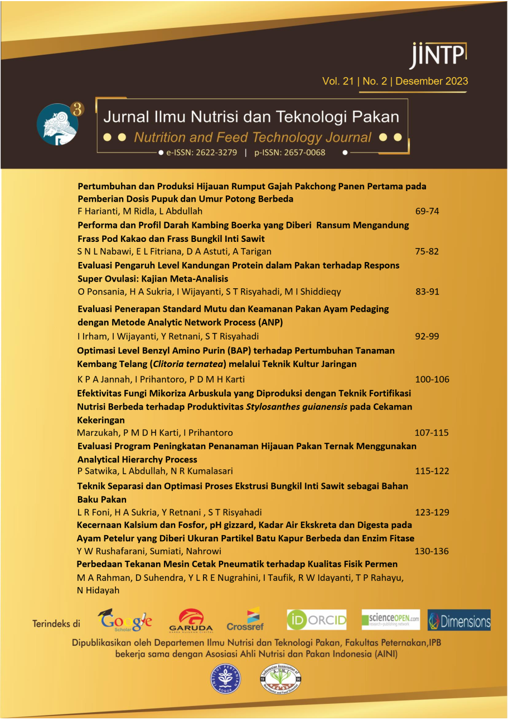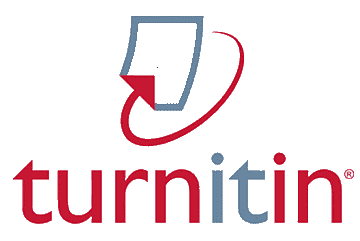Evaluasi Program Peningkatan Penanaman Hijauan Pakan Ternak Menggunakan Analytical Hierarchy Process
Evaluation of Forage Cultivation Improvement Program Using Analytical Hierarchy Process
Abstract
ABSTRACT
The purposes of this research were to evaluate the effectiveness of the forage planting program in achieving the objectives and to formulate a strategy for the development of the forage program. Primary data were obtained through direct observation in the field and filling out a list of questionnaires by the resource persons. The process of collecting data for the evaluation of the forage planting program was carried out in six provinces, i.e., the provinces of Lampung, Central Java, West Nusa Tenggara, South Sulawesi, South Kalimantan and West Papua (purposive sampling). Data analysis was carried out through the analytical hierarchy process (AHP), which was a functional hierarchy, with the main input being human perception. The number of sources for the AHP method was 22 sources consisting of heads of the Directorate of Feed, agencies in charge of animal husbandry in provinces and districts, as well as farmers group. It could be concluded that that the actor that ranks first in the strategy for developing the forage planting program was the farmers group, followed by the district, provincial and central government. The most influencing factor in the strategy for developing a forage planting program was land, followed by climate, production inputs, regional commitment and forage cultivation. The strategy considered important in the development of forage planting programs was forage planting in the rainy season. The results of AHP analysis on the most influential actors and factors, farmers group and land, could be used as a reference for policy makers in developing strategies for developing forage planting programs.
Key words: analytical hierarchy process, cattle, evaluation, feed, forage
Downloads
References
Abadi M, Nafiu L.O & Karim, J. 2019. Pemetaan potensi sumberdaya lahan hijauan pakan ternak sapi bali di kecamatan Tinanggea kabupaten Konawe Selatan. Jurnal Ilmu dan Teknologi Peternakan Tropis, 6(1):124-137.
Arsjad LM. 2014. Pemilihan hijauan makanan ternak (HMT) berdasarkan kondisi agroekosistem. Prosiding Temu Teknis Jabatan Fungsional Non Peneliti Tahun 2014, Pontianak (ID): Badan Penelitian dan Pengembangan Pertanian, Kementan RI
Budiari NLG & Suyasa IN. 2019. Optimalisasi pemanfaatan hijauan pakan ternak (HPT) lokal mendukung pengembangan usaha ternak sapi. Pastura 8(2): 118-122.
Delima M, Karim A & Yunus, M. 2015. Kajian potensi produksi hijauan pakan pada lahan eksisting dan potensial untuk meningkatkan populasi ternak ruminansia di kabupaten Aceh Besar. Jurnal Agripet 15(1): 33-40.
Direktorat Pakan. 2021. Rencana Strategis Direktorat Pakan 2020-2024 Revisi-II. Jakarta (ID): Direktorat Pakan
Direktorat Jenderal Peternakan dan Kesehatan Hewan. 2022. Pedoman Pengembangan Sapi Potong Berbasis Padang Penggembalaan dan Integrasi Sapi-Sawit. Jakarta (ID): Direktorat Jenderal Peternakan dan Kesehatan Hewan.
Direktorat Jenderal Peternakan dan Kesehatan Hewan. 2021. Petunjuk Teknis Kegiatan Peningkatan Produksi Pakan Ternak Tahun Anggaran 2022. Jakarta (ID): Direktorat Jenderal Peternakan dan Kesehatan Hewan
Elly FH, Waleleng, Lumenta I.D.R & Oroh, F.N.S. 2013. Introduksi Hijauan Makanan Ternak Sapi di Minahasa Selatan. Pastura 3(1): 5-8.
Hasan, S. 2012. Hijauan Pakan Tropik. Bogor (ID): IPB Press.
Novriandeni E & Zuhdi, F. 2022. Pengembangan Hijauan Pakan Ternak Berkualitas Mendukung Program Upsus Siwab di Provinsi Riau. Bulletin Inovasi Pertanian. 1(7): 1-9.
Oelviani R. 2013. Penerapan metode Analytic Hierarchy Process untuk merumuskan strategi penguatan kinerja sistem agribisnis cabai merah di Kabupaten Temanggung. Jurnal Informatika Pertanian 22(1):11-19.
Padmowati RDE. 2009. Pengukuran indeks konsistensi dalam proses pengambilan keputusan menggunakan metode AHP. Seminar Nasional Informatika. Yogyakarta (ID): UPN Veteran Yogyakarta
Purnamasari L, Basuki, Khasanah, H & Sari V.G. 2023. Penguatan Pembibitan Sapi Potong Lokal Melalui Introduksi Hijauan Makanan Ternak di Desa Klabang, Kecamatan Tegalampel, Bondowoso. Jurnal Pengabdian Masyarakat Berkemajuan 7(1).
Renaningtyas R & Hariyanti P. 2021. Penerapan komunikasi penyuluhan pertanian milenial pada Pusat Pelatihan Pertanian dan Pedesaan Swadaya (P4S) di Desa Betet Kabupaten Nganjuk Jawa Timur. Jurnal Mahasiswa Komunikasi Cantrik 1(2):67- 80
Saaty TL. 1990. How to Make a Decision: The Analytic Hierarchy Proses. European Journal of Operational Research 48: 9-26.
Suci TY & Jamil AS. 2019. Hubungan tingkat kepuasan pelayanan dengan keberhasilan peserta pelatihan teknis bagi penyuluh pertanian. Jurnal Hexagro 3(2):47-56.
Susanto A, Suratman, Pamungkas FA, Shiddieqy MI, Zuratih, Chasanah N, Cesart RA & Tiesnamurti B. 2022. Wilayah Unggulan Pengembangan Ternak Ruminansia. Bogor (ID): IPB Press.
Syahputra BSA, Siregar DJS, Rossanty Y. 2019. Potensi pengembangan pakan hijauan ternak pada lahan terbiar desa. Jurnal Prodikmas 3(2):12-21.
Utami S & Rangkuti K. 2021. Sistem pertanian terpadu tanaman ternak untuk peningkatan produktivitas lahan: A Review. Agriland Jurnal Ilmu Pertanian 9(1): 1-6.
Yulianto, R., Nurwidodo, Widianingrum, D.C., Khasanah, H. 2022. Budidaya Rumput Odot dan Teknologi Pengawetan Hijauan Pakan Ternak Sapi didesa Kalibendo, Kecamatan Pasirian, Lumajang. Jurnal Pengabdian Kepada Masyarakat Indonesia 3(1): 27-3.
Copyright (c) 2023 P Satwika, L Abdullah, N R Kumalasari

This work is licensed under a Creative Commons Attribution 4.0 International License.
The authors of the submitted manuscript have to understand and agree that the copyrights published are held by Jurnal Ilmu Nutrisi dan Teknologi Pakan. Copyrights includes rights in reproducing, distributing and selling every section of articles in all forms and media. The copyright transfer form is signed by the corresponding author. The author”
• Creative Commons Attribution (CC BY)
you are allowed to:
Share – copy and redistribute the material in any medium or format
Adapt – remix, transform, and build upon the material
for any purpose, even commercially.
The licensor cannot revoke these freedoms as long as you follow the license terms.
Jurnal Ilmu Nutrisi dan Teknologi Pakan (Nutrition and Feed Technology Journal)

This work is licensed under a Creative Commons Attribution 4.0 International License.












